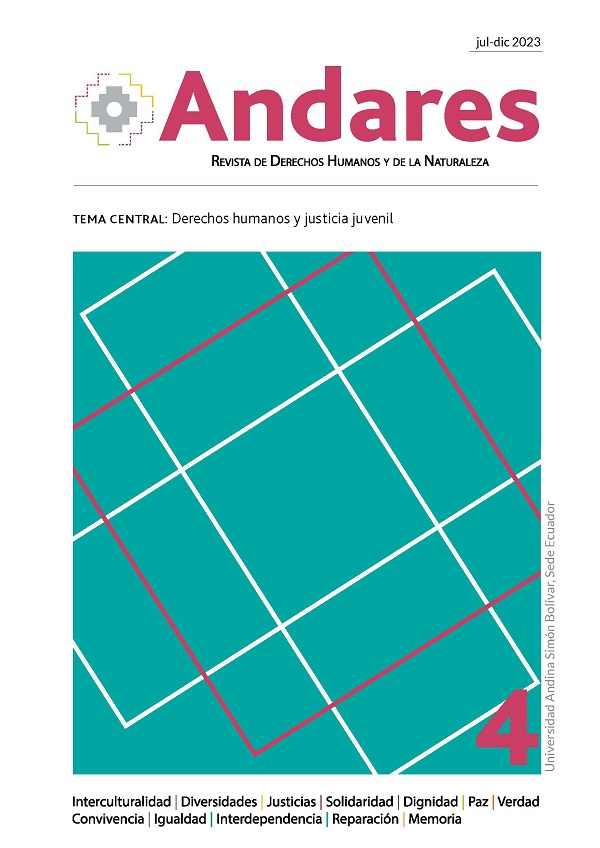Justicia Juvenil Restaurativa: Tendencias Actuales y su Impacto en la Sociedad
DOI:
https://doi.org/10.32719/29536782.2023.2.1Palabras clave:
Justicia Juvenil Restaurativa, Adolescentes Infractores, Responsabilidad Personal, Empoderamiento Juvenil, Reincidencia, Reintegración, Reparación, Sistema PenalResumen
Históricamente, el manejo de adolescentes infractores ha sido un desafío. Por tal razón, este artículo académico pretende exponer cómo la justicia juvenil restaurativa se ha convertido en una alternativa valiosa para abordar esta problemática. Para lograrlo, se llevó a cabo un análisis de conceptos y prácticas internacionales relacionadas con este enfoque. Se destaca la importancia de esta perspectiva para fomentar la responsabilidad personal y el empoderamiento de los adolescentes infractores, así como para reducir la reincidencia y mejorar la reintegración y reparación del daño a las víctimas. Finalmente, se enfatiza la efectividad de la justicia juvenil restaurativa como una opción más comprensiva para abordar los desafíos en el sistema de justicia penal.
Descargas
Referencias
Bazemore, Gordon. “Restorative Justice and Earned Redemption: Communities, Victims, and Offender Reintegration”. American Behavioral Scientist 41, n.° 6 (1998): 768-813. https://doi.org/10.1177/0002764298041006003. DOI: https://doi.org/10.1177/0002764298041006003
—, y Mara Schiff, Juvenile Justice Reform and Restorative Justice: Building Theory and Policy from Practice. Londres: Willan, 2005.
Braithwaite, John. Crime, Shame, and Reintegration. Cambridge, US: Cambridge University Press, 1989. DOI: https://doi.org/10.1017/CBO9780511804618
—. Restorative Justice and Responsive Regulation. Oxford: Oxford University Press, 2002.
Consejo de Europa. Guidelines for a Child-Friendly Approach to Justice. Estrasburgo, FR: Council of Europe Publishing, 2018.
Cox, Steven, Jennifer Allen, Robert Hansen y John Conrad. Juvenile Justice: A Guide to Theory, Policy, and Practice. Nueva York: SAGE, 2017.
Drago, Raymond. Fundamentals of gear design. Oxford: Butterworths, 1988.
Ecuador Corte Constitucional. Caso n.° 9-17-CN. 9 de julio de 2019. https://tinyurl.com/4b6bvcye.
Gavrielides, Theo. Restorative Justice Theory and Practice: Addressing the Discrepancy. Londres: RJ4All, 2020.
Healy, Karen, y Michael Pitts. Handbook of Restorative Justice. Nueva York: Routledge, 2007.
Latimer, Jeff, y Craig Dowden. “A Meta-Analytic Review of Restorative Justice Conferencing Programs’ Effects on Post-Program Recidivism”. Journal of Experimental Criminology 11, n.° 4 (2015): 501-35.
Marshall, Tony, y Sally Merry. Restorative Justice in Urban Schools: Disrupting the School-to-Prison Pipeline. Nueva York: Teachers College Press, 2011.
McCold, Paul, y Barbara Wachtel. “Restorative Justice Theory Validation”. En Restorative Justice and Civil Society, editado por Heather Strang y John Braithwaite, 173-94. Cambridge, US: Cambridge University Press, 2003.
Miranda, Paula, Jorge Farah, Daniela Bolívar, Bianca Baracho y Marcela Fernández. “La mediación penal restaurativa juvenil en el marco del nuevo Servicio nacional de reinserción social juvenil en Chile: Principios y fundamentos de una norma técnica”. Política Criminal 17, n.° 33 (2022). https://tinyurl.com/3v9u7b4u. DOI: https://doi.org/10.4067/S0718-33992022000100229
Morales, Hugo, María Ángeles Luengo y Cándido da Agra. “Efectividad de las medidas socioeducativas impuestas por la administración de justicia juvenil en la reintegración social de adolescentes infractores: Una revisión crítica”. International Annals of Criminology 51, n.° 1-2 (2013): 133-55. https://tinyurl.com/nhkny9sr DOI: https://doi.org/10.1017/S000344520000009X
Morris, Allison, y Gabrielle Maxwell. “Young People’s Experiences and Perceptions of Restorative Justice in New Zealand”. British Journal of Criminology 59, n.° 3 (2019): 564-85.
—, Gilly Maxwell y Maggie Halsey. Restorative Justice and the Secure Estate: Alternatives for Young People in Custody. Bristol, UK: Policy Press, 2016.
ONU Oficina contra las Drogas y el Delito. Handbook on Restorative Justice Programmes. Washington DC: UNODC, 2012.
Schwalbe, Casey, y Raymond Gearing. “Restorative Justice Conferencing: A Meta-Analysis of Post-Offense Outcomes”. Restorative Justice 3, n.° 1 (2015).
Strang, Heather, y John Braithwaite, ed. Restorative Justice and Family Violence. Cambridge, UK: Cambridge University Press, 2002.
Umbreit, Mark. “Victim-Offender Mediation in Canada: The Impact of an Emerging Social Work Intervention”. International Social Work 42, n.° 2 (1999): 215-27. https://doi.org/10.1177/002087289904200209. DOI: https://doi.org/10.1177/002087289904200209
Van Ness, Daniel, y Karen Heetderks Strong. Restoring Justice: An Introduction to Restorative Justice. Nueva York: Routledge, 2014. DOI: https://doi.org/10.4324/9781315721330
Zehr, Howard. Changing Lenses: A New Focus for Crime and Justice. Harrisonburg, US: Herald Press, 1990.






